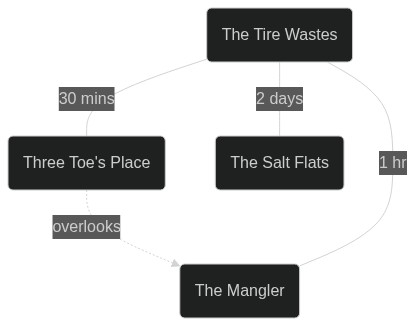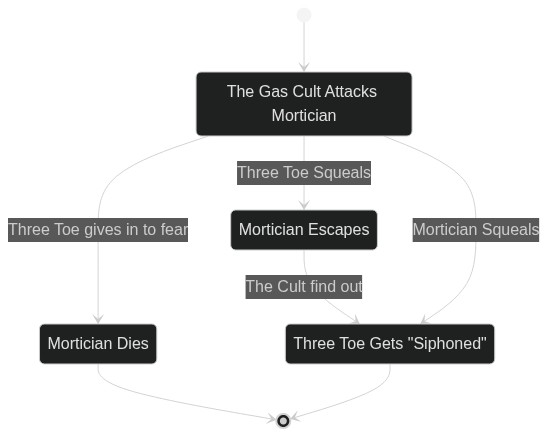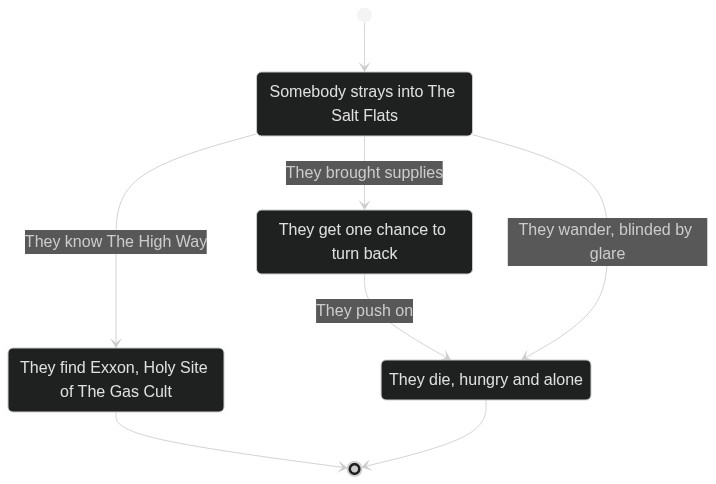Alternative Data Structures for RPGs 1: Graphs
I believe RPG designs can centre around the clever use of a data structure. Many RPGs are based around tables and lists alone. The data structure you use heavily shapes how you interact with the data therein by changing the base verbs you use, so I think if we use a bigger variety of data structures we'll see a bigger variety of cool RPG mechanics.
Graphs
Outside of maths circles you probably know these as networks. Points (nodes) connected by lines (edges), like a train network map. The lines (aka edges) can go one or both ways. The nodes can hold data, but so can the edges.
Also FYI all graphs here are built with the markdown plugin mermaid
Why use them?
Graphs are a good way of pre-encoding complex relationships. These could be between people, places, things, actions that characters can take, or really anything. They can often limit choices, but sometimes that's exactly what you need.
Use Cases
Maps
one common use for graphs is in point crawl maps. These often use weights (numerical values assigned to the edges) to determine distance (and therefore resource usage!)
- 💡 An Oregon Trail style game about a pilgrim having to prep, plan and compromise their ideals to reach the holy land, where their path includes both practical and moral considerations
Relationships
You can also use graphs for relationship diagrams. Nodes are entities in your fiction and edges are the relationships between them. You can use weights to represent closeness, or labels to show the nature of the relationship.
- 💡 A strategic RPG of social manipulation to climb your machievellian ladder to Class President
State Machines
One other use for graphs is state machines. These describe a sequence of interdependent actions, and you move around it much like you'd navigate a train network. This is how video games will often manage the AI of NPCs. But why stop there? Sure you could use a state machine for an AI enemy or companion:
- 💡 A Poirot inspired game of deducing the structure of the graph to uncover the truth behind the lord of the manor's murder
...but why not get adventure book-y with a mechanical GM?
- 💡 Groundhog day: The RPG
or even have your PCs interactions be determined by a complex interlocking network of state machines tracking their different moods and compulsions (I got tired at this point and didn't want to make more graphs but you could try making one for yourself with mermaid). Imagine there's a cool graph here: 🧔→🤺→☠
Algorithms and Interactions
Graphs are cool because it's really easy to add and remove nodes to make or break relationships, or to change the labels and weights between them. But they also make it easy as a designer or GM to visualise stuff like:
- How could Character A know character C? Who do they both interact with?
- Which aspects of my fiction/game overlap and can affect each other, and which don't?
- Where could I encourage players to take a more diverse range of actions to get what they want?
or to provide gameplay that can :
- provide players with tough choices about what's important to them, given limited options
- allow players to assess spatial puzzles as fictional dilemmas and vice versa
- automate the fictional spackling that would normally be left to a GM to do to figure out the PCs place in the world
(originally posted to my Cohost but fuck social media tbh)
Find more of my work at my personal site goblin.zone



